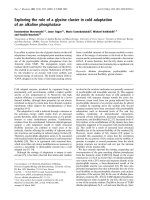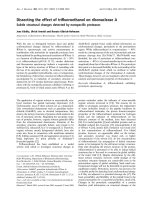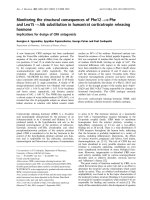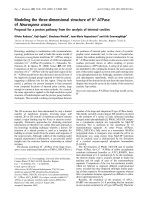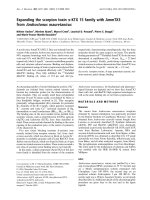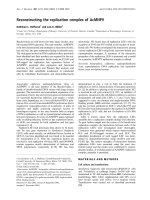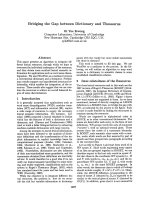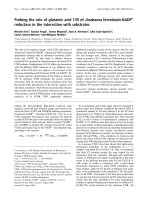Báo cáo y học: "Stress, the stress response system, and fibromyalgia" ppt
Bạn đang xem bản rút gọn của tài liệu. Xem và tải ngay bản đầy đủ của tài liệu tại đây (156.38 KB, 7 trang )
Page 1 of 7
(page number not for citation purposes)
Available online />Abstract
Stress is a state of disharmony, or threatened homeostasis. A stressor
could have a psychological origin or a biological origin. Societies have
become more intricate with industrialization, and modern individuals
try to adapt to the new defiance by forcing their stress response
system. The main component of the stress response network is the
autonomic nervous system. The present article reviews current
knowledge on autonomic dysfunction in fibromyalgia. Sympathetic
hyperactivity has been consistently described by diverse groups of
investigators. Fibromyalgia is proposed to be a sympathetically
maintained neuropathic pain syndrome, and genomic data support
this contention. Autonomic dysfunction may also explain other fibro-
myalgia features not related to pain.
Introduction
Living organisms survive by maintaining harmonious
equilibrium or homeostasis. Stress can be defined as a state
of disharmony, or threatened homeostasis. For human beings
a stressor could have a psychological origin (ongoing anger,
anxiety, or depression) but can also originate from a
biological insult (an infection, a burn, or a myocardial infarc-
tion). The term stress or stressor should therefore not be
restricted to psychological events but, rather, should be
viewed in an ample physiological context.
The stress response system is a delicate, dynamic system
that vertebrate animals have in order to maintain homeostasis.
The main components of this system are the autonomic
nervous system (ANS) and the hypothalamic–pituitary adrenal
axis. These two branches closely interact with each other and
have positive reverberating feedback loops at different levels.
If the capacity of the stress response system to adapt is over-
whelmed, chronic diseases may appear [1].
Evolution imposes new challenges on all living organisms.
Human societies have become more intricate and stressed
with industrialization. An example of the new defiance is the
alteration in the circadian rhythm. For many thousands of
years, the day and night cycles were harmonious with external
cues: light, noise, and activity during the day; darkness, rest,
and quietness at night. In past decades, however,
industrialization has clearly disturbed this harmony.
Nowadays there can be light, activity, and noise at night. This
and many other stressors of modern societies undoubtedly
have an impact on human health.
Research performed in the past decade with novel
instruments has shown that patients with fibromyalgia (FM)
frequently have dysfunction of the stress response system.
Furthermore, emerging clues propose that such dysfunction
may be important in the pathogenesis of the syndrome. The
present article attempts to update recent research on the
behavior of the principal component of the stress response
system, the ANS, in patients with FM.
Autonomic nervous system
The ANS is the main regulatory system of the body in charge
of maintaining essential involuntary functions, such as the so-
called vital signs (blood pressure, pulse, respiration, and
temperature). The ANS balances the function of all internal
organs, with the heart rate, intestinal motility, urination, and
sexual activity, among many other variables, all regulated by
the system.
One striking characteristic of the ANS network is the rapidity
and intensity of onset of its action and its dissipation. The
ANS is activated by centers located in the spinal cord, brain
stem hypothalamus, and thalamus. These centers also
receive input from the limbic area and other higher brain
regions. Emotions (fear, anger, and panic) therefore have
immediate biological responses (pupil dilation, paleness, and
Review
Biology and therapy of fibromyalgia
Stress, the stress response system, and fibromyalgia
Manuel Martinez-Lavin
National Institute of Cardiology, Juan Badiano 1, 14080 Mexico City, Mexico
Corresponding author: Manuel Martinez-Lavin,
Published: 6 July 2007 Arthritis Research & Therapy 2007, 9:216 (doi:10.1186/ar2146)
This article is online at />© 2007 BioMed Central Ltd
See related editorial by Eisinger, />ANS = autonomic nervous system; COMT = catechol-O-methyltransferase; FM = fibromyalgia.
Page 2 of 7
(page number not for citation purposes)
Arthritis Research & Therapy Vol 9 No 4 Martinez-Lavin
tachycardia). The ANS may be viewed as the interface
between mind and body functions in charge of the basic fight
or flight reaction.
The peripheral autonomic system is divided into two
branches; sympathetic and parasympathetic. These two
divisions have antagonistic actions on most bodily functions
and thus their proper balance preserves homeostasis. The
action of these two branches is mediated by neuro-
transmitters. Catecholamines are the sympathetic neuro-
transmitters. The naturally occurring catecholamines are
norepinephrine, epinephrine, and dopamine. The three
substances act as neurotransmitters within the central
nervous system. Norepinephrine transmits impulses also in
peripheral postganglionic nerve endings and exerts its effects
locally, in the immediate vicinity of its release, whereas
epinephrine is the circulating hormone of the adrenal medulla
and influences processes throughout the body [2].
The major metabolic transformation of catecholamines
involves methylation and oxidative deamination. Methylation is
catalyzed by the enzyme catechol-O-methyltransferase
(COMT) and occurs throughout the body, whereas oxidative
deamination is promoted by monoamine oxidase and takes
place mainly in the synaptic cleft. The COMT gene is located
in region q11.21 of chromosome 22. This gene has abundant
functional polymorphism. The better known transition occurs
in codon 158 with a guanine-to-adenosine substitution, a
polymorphism that results in functional alterations of the
corresponding enzyme. The val/val genotype gives rise to an
effective enzyme whereas the met/met genotype produces a
‘lazy’ enzyme unable to effectively clear catecholamines from
the system [3].
Recent research has found other frequent polymorphisms of
the COMT gene that induce an even more defective enzyme.
Most of these newly found polymorphisms are in linkage
disequilibrium with the val-158-met transition. These
polymorphisms can be grouped into ‘haplotypes’. It has been
shown that a particular COMT gene haplotype named HPS
gives rise to a defective enzyme, 11 times less efficient than
the enzyme generated by the LPS haplotype. Interestingly,
this HPS haplotype is associated with high pain sensitivity in
healthy females [4]. This newly generated evidence supports
the notion that the intensity of sympathetic function is in part
genetically determined, and that a ‘hyperadrenergic state’ is
associated with pain hypersensitivity.
Clinical assessment of autonomic nervous
system function
The function of the ANS has been difficult to evaluate in
clinical practice. Changes in breathing pattern or mental
stress, or even posture, alter immediately and completely the
sympathetic/parasympathetic balance. This dynamic system
could therefore not be properly studied by ‘static’ tests such
as the levels of circulating neurotransmitters, and less so by
their urinary catabolites. Bedside maneuvers to assess ANS
function have included measurements of supine and standing
pulse and blood pressure. Sustained drops in systolic blood
pressure (>20 mmHg) or diastolic blood pressure
(>10 mmHg) after standing for 3 minutes that are not
associated with an increase in the pulse rate >30 beats per
minute suggest autonomic deficit.
Opportunely, two research instruments have been recently
introduced to aid in clinical research of cardiovascular
autonomic function: heart rate variability analysis and the tilt
table test. These two instruments have been used to study
the pathogenesis of FM.
Heart rate variability analysis
The method is based on the well-known fact that the heart
rate is not fixed, but varies from beat to beat constantly. The
antagonistic effects of the sympathetic and parasympathetic
branches of the ANS on the sinus node harmonize the
periodic components of this constant variability. Heart rate
variability can be studied in the time domain, where the basic
units are milliseconds. Time-domain mathematical calcula-
tions include, among others, the standard deviation of all R–R
interval durations as well as the percentage of adjacent pairs
of R–R intervals that differ by more than 50 milliseconds from
each other in a given time period. The higher time domain
variability indexes signify more parasympathetic influx on the
sinus node.
Heart rate variability can also be studied in the frequency
domain using spectral analysis, where the basic units are
Hertz (cycles per second). Pharmacological and clinical
studies have established that the high-frequency-band
spectral power reflects parasympathetic activity on the heart.
These cycles of variability are harmonious with respiratory
rhythm. The sympathetic division modulates a less frequent
oscillations through the arterial baroreceptors. Since the two
branches of the ANS have antagonistic effects on the sinus
node, the low-frequency-band/high-frequency-band ratio is
regarded as a reflection of sympathetic activity [5].
Tilt table test
The tilt table test is another useful tool to study orthostatic
intolerance and syncope. The method is based on the
physiological changes that occur after adopting an upright
posture with pooling of approximately 700 ml blood in the
lower parts of the body. In normal circumstances, the ANS
quickly compensates this relative volume loss by increasing
vascular tone and cardiac output. This mechanism avoids
hypotension and inadequate cerebral perfusion. Tilt table
testing examines this response in a controlled environment.
With passive orthostasis, additional stress is exerted on the
sympathetic nervous system by blocking the influence of
muscle contraction that could increase venous return.
Subjects are supine for 30 minutes in the first step. The
subject is then tilted upright for 30–45 minutes at an angle of
Page 3 of 7
(page number not for citation purposes)
60–80°. Pharmacological stimulation with isoproterenol is
sometimes used as an additional step.
The normal responses to tilting consist of an increase in the
heart rate of 10–15 beats per minute, an elevation of diastolic
blood pressure of about 10 mmHg, and little change in systolic
pressure. There are two types of abnormal responses. One
such response is orthostatic hypotension, defined as a
reduction of systolic blood pressure of at least 20 mmHg or a
reduction of diastolic blood pressure of at least 10 mmHg. This
hypotension may induce syncope. The other type of abnormal
response is postural orthostatic tachycardia, which consists of
a sustained increase of heart rate of at least 30 beats per
minute or a sustained pulse rate of 120 beats per minute. Tilt
table testing has been used mostly to study syncope in
patients with no evidence of structural heart disease [6].
Autonomic nervous system dysfunction in
fibromyalgia
Evidence accumulated through the years has shown that
autonomic dysfunction is frequent in FM. Bengtsson and
Bengtsson published the first study in 1988, which was a
controlled therapeutic trial of stellate ganglion blockade. They
reported marked improvement of regional pain and
tenderness as the response to this maneuver, in contrast to
the lack of effect after a sham injection in the neck area [7].
Vaeroy and colleagues, using Doppler probes to measure
skin blood flow in the hands, subsequently found that FM
patients have less vasoconstrictory response to acoustic
stimulation and cooling. These authors concluded that the
cutaneous manifestations of FM previously interpreted as
Raynaud’s phenomenon should be reconsidered [8].
van Denderen and colleagues studied the influence of
maximum exercise in 10 patients with FM and in 10 healthy
sedentary control individuals. These authors found lower
norepinephrine production together with the lower heart rate
after exercises, suggesting a disturbance of the sympathetic
reactivity in FM patients [9]. Elam and colleagues recorded
muscle sympathetic activity with microelectrodes placed at
the peroneal nerve level. They found no exaggerated
sympathetic activity in FM subjects; nevertheless, these
patients displayed less pronounced sympathetic activity as a
response to muscle contraction [10].
Since the publication of these studies, little attention was
paid to dysautonomia in FM until a decade ago, with the
introduction of heart rate variability and tilt table testing in the
study of FM pathogenesis.
Heart rate variability analysis and tilt table
testing in fibromyalgia
Different groups of investigators have reported abnormal
heart rate variability in subjects with FM [11-17]. Table 1
summarizes such data. All controlled studies in women have
described, without exception, changes consistent with
exaggerated sympathetic activity. There are two published
heart rate variability analyses in men with FM, one of which
did not find signs of resting sympathetic hyperactivity.
Several groups of investigators have additionally tested the
response of FM patients to different stressors [13,18-21].
The results are summarized in Table 2. Diverse reports agree
with the concept that subjects with FM have a deficient
sympathetic response to different types of stressors.
On the bases of this presented evidence it can be safely
stated that patients with FM display prominent dysautonomia
when studied by means of heart rate variability analysis and/
or the tilt table test. This dysautonomia can be characterized
as a sympathetic nervous system that is persistently hyper-
active but is hyporeactive to stress. This apparent paradox
(sympathetic hyperactivity with hyporeactivity) nevertheless
agrees with the basic physiological principle demonstrating
that chronic hyperstimulation of the β-adrenergic receptors
leads to receptor desensitization and downregulation.
Available online />Table 1
Controlled heart rate variability analyses in patients with fibromyalgia
Number of Number of Duration of heart
Reference patients controls rate variability analysis Main conclusion
Martinez-Lavin and colleagues, 1998 [11] 30 women 30 women 24 hours Sympathetic hyperactivity
Cohen and colleagues, 2000 [12] 22 women 22 women 20 minutes Sympathetic hyperactivity
Raj and colleagues, 2000 [13] 17 women 14 women 24 hours Sympathetic hyperactivity
Cohen and colleagues, 2001 [14] 19 men 19 men 20 minutes Sympathetic hyperactivity
Stein and colleagues, 2004 [15] 26 (19 women, 36 (18 women, 24 hours Sympathetic hyperactivity
7 men) 18 men) in women, not in men
Furlan and colleagues, 2005 [16] 16 women 16 women 30 minutes Sympathetic hyperactivity
Ulas and colleagues, 2006 [17] 34 women 22 women 30 minutes Sympathetic hyperactivity
It should be noted, however, that so far there is no autonomic
measure that comes close to being sensitive or specific for
FM. Different studies have shown that the FM groups have
mean values significantly different from control groups, but
there is considerable overlap between patients and control
individuals. An explanation for this overlap could be the
extremely variable behavior of the ANS. Abnormalities
therefore cannot be detected on an individual basis but only
when groups are compared. On the other hand, the heart rate
variability findings reported by independent groups of
investigators represent the most consistent alteration so far
described in women with FM.
Dysautonomia may explain the multisystem
features of fibromyalgia
ANS dysfunction may explain the diverse clinical manifes-
tations of FM [22]. It has been suggested that, due to a
ceiling effect, the hyperactive sympathetic nervous system of
such patients becomes unable to further respond to different
stressors, thus explaining the constant fatigue and morning
stiffness these patients suffer. Relentless sympathetic
hyperactivity may explain sleep disorders, anxiety, pseudo-
Raynaud’s phenomenon, sicca symptoms, and intestinal
irritability.
Kooh and colleagues performed concurrent analyses of heart
rate variability and polysomnography in 10 subjects with FM
and compared them with and an age/sex-matched controlled
group. The authors reported changes consistent with
nocturnal sympathetic hyperactivity. Such changes coincided
with increased nocturnal arousal-awakening episodes [23].
Other investigators have shown that in normal sleeping
persons electrocardiographic signs of sympathetic surge
precede arousal/awakening episodes. This body of evidence
suggests that sympathetic hyperactivity in FM causes the
excessive arousal/awakening episodes [24].
Sympathetically maintained pain concept
For many years it has been assumed that abnormal activity of
the sympathetic nervous system may be involved in the
pathogenesis of chronic pain syndromes. This assumption
was based mainly upon the observations that the pain is
spatially correlated with signs of autonomic dysfunction, with
the fact that blocking the efferent sympathetic supply to the
affected region relieves the pain, and with the observation
that norepinephrine injections rekindle the pain.
The sympathetically maintained pain concept has strong and
ample foundations in the animal model. In contrast, the
clinical information sustaining this pathogenesis is mostly
anecdotal and does not, in most instances, fulfill the strict
evidence-based medicine criteria [25].
Animal studies of sympathetically maintained pain
Under normal circumstances primary afferent nociceptors do
not have catecholamine sensitivity. Under pathological
conditions, however, particularly after trauma, a sympathetic–
afferent interaction can be established both at the peripheral
and central levels.
In a rabbit model, after peripheral nerve injury, sympathetic
stimulation and norepinephrine are excitatory for a subset of
skin C-fibers nociceptors that express α
2
-adrenergic-like
receptors [26]. Perhaps more germane to the pathogenesis
of sympathetically maintained pain are the experimental
models that have been extensively reproduced, in which
Arthritis Research & Therapy Vol 9 No 4 Martinez-Lavin
Page 4 of 7
(page number not for citation purposes)
Table 2
Controlled studies of stress testing using the tilt table or heart rate variability analysis in patients with fibromyalgia
Number of Number of
Reference Type of stress test patients controls Main conclusion
Martinez-Lavin and Active orthostatic stress 19 19 Orthostatic sympathetic
colleagues, 1997 [18] derangement
Bou-Holaigah and Head-up tilt table test 20 (17 female) 20 (18 female) Hypotension in 60%
colleagues, 1997 [19] of patients (0% in controls)
Raj and colleagues, 2000 [13] Head-up tilt table test 17 14 Positive test in 64% of
patients and 21 controls
Naschitz and colleagues, ‘Discriminant score’ during 38 30 with chronic Discriminant score different in
2001 [20] head-up tilt table test (67% female) fatigue syndrome fibromyalgia versus chronic
(58% female), fatigue syndrome
37 normal
(65% female)
Friederich and colleagues, Mental stress, passive 28 15 Less sympathetic activation
2005 [21] orthostatism
Furlan and colleagues, Head-up tilt table test, 16 (15 female) 16 (15 female) Decreased sympathetic response
2005 [16] muscular sympathetic nerve activity
sympathetic sprouting at the dorsal root ganglia becomes
apparent after nerve injury and forms basket-like structures
around large-diameter axotomized sensory neurons; sympa-
thetic stimulation can activate such neurons repetitively [27].
Fibromyalgia as a sympathetically maintained pain
syndrome
The defining FM features (widespread pain plus tenderness
at palpation on specific anatomical points), as well as the
paresthesias that these patients have, could theoretically be
explained by the pathogenesis known as ‘sympathetically
maintained pain’. This type of neuropathic pain is
characterized by its frequent post-traumatic onset and by the
presence of stimuli-independent pain perception accom-
panied by paresthesias and allodynia [25], which are
precisely FM pain features. Different controlled studies have
determined that subjects with FM have higher rates of
physical or emotional trauma prior to the onset of their
symptoms [28]. FM is clearly a stimulus-independent pain
state since there is no underlying structural damage and
inflammatory signs are conspicuously absent. Most patients
with FM have paresthesias, as demonstrated in the original
study that lead to the American College of Rheumatology
criteria. In that original study, more than 80% of patients with
FM had such sensory alteration. The studies of Simms and
Goldenberg and of Martinez-Lavin and colleagues
corroborated this high prevalence of paresthesias in FM
[29,30]. Several groups of investigators have defined that the
typical FM tender points reflect a state of generalized
allodynia [31]. Additional arguments that favor the
involvement of the sympathetic nervous system in the genesis
of FM pain are the reports describing such pain as appearing
submissive to sympatholytic maneuvers and to be rekindled
by norepinephrine injections [32].
A prototype of sympathetically maintained pain syndrome is
reflex sympathetic dystrophy (nowadays named Complex
Regional Pain Syndrome type I). There are important points of
coincidence between reflex sympathetic dystrophy and FM.
Both conditions affect mostly females and have frequent
post-traumatic onset. Both entities are characterized by
stimuli-independent chronic pain, allodynia, paresthesias, and
vasomotor instability. We therefore proposed that FM is a
generalized form of reflex sympathetic dystrophy [33].
Emerging genomic evidence supports the concept of FM as a
sympathetically maintained pain syndrome. As mentioned
above, the COMT enzyme is the main catecholamine
catabolic pathway. Two different groups of investigators
reported that subjects with FM less frequently have the val-
158-val genotype of the COMT gene when compared with
healthy control individuals. This genotype induces an
‘effective’ catecholamine-clearing enzyme [34,35]. These
preliminary results suggest that females that do not degrade
catecholamines properly have higher risk to develop FM.
Fibromyalgia as a neuropathic pain syndrome
The International Association for the Study of Pain defines
neuropathic pain as ‘pain initiated or caused by a primary
lesion or dysfunction of the nervous system’ [36]. A more
restrictive definition of neuropathic pain has been proposed
recently [37]. It has been suggested that neuropathic pain
should be diagnosed only when there is evidence of nervous
system damage. Nevertheless, the clinical importance of
neuropathic pain resides not in the nerve lesion itself, but in
the resulting nerve dysfunction. There are other clinical
syndromes classified as neuropathic pain in which no
nervous system damage is obvious (for example, trigeminal
neuralgia or reflex sympathetic dystrophy).
Available online />Page 5 of 7
(page number not for citation purposes)
Figure 1
Theoretical etiopathogenetic mechanisms in fibromyalgia. See text for details. COMT, catechol-O-methyltransferase.
It would be difficult to ascribe the concurrent presence of
pain allodynia and paresthesias (which characterizes FM) to a
pathogenesis different from an intrinsic nervous system
alteration.
Another argument to consider FM a neuropathic pain
syndrome comes from the reports of central nervous system
sensitization. Patients with FM demonstrate abnormal
temporal summation of pain [38] and have abnormal spinal
cord reflexes [39]. Central sensitization is the expression of
neuroplasticity and is the major cause of hypersensitivity to
pain after injury. ‘Central pain’ is a type of neuropathic pain.
An additional argument for the neuropathic origin of FM is a
controlled study demonstrating that FM pain improves with
antineuropathic medications [40].
Treatment of autonomic dysfunction in
fibromyalgia
The current therapy for fibromyalgia is far from adequate.
Nonpharmacologic therapies found partly effective are those
interventions that also improve resting autonomic tone, such as
graded aerobic exercises and cognitive-behavioral therapy [41].
There have been no double-blind investigations using
adrenergic-blocking agents in FM. An open study using
pindolol, however, reported beneficial effects [42]. It seems
unlikely that adrenergic blocking agents may reverse FM pain
completely since neuroplasticity is an irreversible alteration.
A dopamine agonist, pramipexole, has been found effective in
a single-center double-blind investigation [43].
As previously mentioned, well-designed studies have shown
that antineuropathic medications such as pregabalin are
useful in FM [40].
Conclusions
Figure 1 synthesizes our proposal for the pathogenesis of
FM. The algorithm is based on emerging scientific data. FM
can be viewed as a disease of modern times, in which the
main regulatory system of the body unsuccessfully attempts
to adapt to contemporary stressful lifestyles. High-risk
individuals would be those with defective catecholamine-
degrading enzymes. Central to the pathogenesis of the illness
is a constant hyperadrenergic state that could lead to a
breakdown of the system. In such instances neuroplasticity
takes place, establishing abnormal connections between the
sympathetic nervous system and the nociceptive fibers. The
resulting clinical syndrome would be a neuropathic type of
pain. Dysautonomia can also explain other FM symptoms.
Further research is needed to probe this novel paradigm.
Competing interests
The author declares that they have no competing interests.
References
1. Chrousos GP, Gold PW: The concepts of stress and stress
system disorders. Overview of physical and behavioral home-
ostasis. JAMA 1992, 267:1244-1252.
2. Hoffman BB, Taylor P: Neurotransmission. the autonomic and
somatic nervous system. In The pharmacological basis of thera-
peutics. Goodman & Gilman’s 10th ed. Edited by Hardman JG,
Limbird LE. New York: McGraw-Hill; 2001:115-154.
3. Zubieta JK, Heitzeg MM, Smith YR, Bueller JA, Xu K, Xu Y,
Koeppe RA, Stohler CS, Goldman D: COMT val158met geno-
type affects mu-opioid neurotransmitter responses to a pain
stressor. Science 2003, 299:1240-1243.
4. Diatchenko L, Slade GD, Nackley AG, Bhalang K, Sigurdsson A,
Belfer I, Goldman D, Xu K, Shabalina SA, Shagin D, et al.:
Genetic basis for individual variation of pain perception and
the development of a chronic pain condition. Hum Mol Genet
2005, 14:135-143.
5. Task Force of the European Society of Cardiology and the North
American Society of Pacing and Electrophysiology: Heart rate
variability standards of measurement, physiological interpre-
tation, and clinical use. Circulation 1996, 93:1043-1065.
6. Hermosillo AG, Marquez MF, Jauregui-Renau K, Cardenas M:
Orthostatic hypotension 2001. Cardiol Review 2001, 9:339-347.
7. Bengtsson A, Bengtsson M: Regional sympathetic blockade in
primary fibromyalgia. Pain 1988, 33:161-167.
8. Vaeroy H, Qiao Z, Morkrid L, Forre O: Altered sympathetic
nervous system response in patients with fibromyalgia.
J Rheumatol 1989, 16:1460-1465.
9. van Denderen JC, Boersma JW, Zeinstra P, Hollander AP, van
Neerbos BR: Physiological effects of exhaustive physical exer-
cise in primary fibromyalgia syndrome (PFS): is PFS a disor-
der of neuroendocrine reactivity? Scand J Rheumatol 1992, 21:
35-37.
10. Elam M, Johansson G, Wallin BG: Do patients with primary
fibromyalgia have an altered muscle sympathetic nerve activ-
ity? Pain 1992, 48:371-375.
11. Martinez-Lavin M, Hermosillo AG, Rosas M, Soto ME: Circadian
studies of autonomic nervous balance in patients with
fibromyalgia. A heart rate variability analysis. Arthritis Rheum
1998, 42:1966-1971.
12. Cohen H, Neumann L, Shore M, Amir M, Cassuto Y, Buskila D:
Autonomic dysfunction in patients with fibromyalgia: applica-
tion of power spectral analysis of heart rate variability. Semin
Arthritis Rheum 2000, 29:217-227.
13. Raj RR, Brouillard D, Simpsom CS, Hopman WM, Abdollah H:
Dysautonomia among patients with fibromyalgia: a non-
invasive assessment J Rheumatol 2000, 27:2660-2665.
14. Cohen H, Neumann L, Alhosshle A, Kotler M, Abu-Shakra M,
Buskila D: Abnormal sympathovagal balance in men with
fibromyalgia. J Rheumatol 2001, 28:581-589.
15. Stein PK, Domitrovich PP, Ambrose K, Lyden A, Fine M, Gracely
RH, Clauw DJ: Sex effects on heart rate variability in
fibromyalgia and Gulf War illness. Arthritis Rheum 2004, 51:
700-708.
16. Furlan R, Colombo S, Perego F, Atzeni F, Diana A, Barbic F, Porta
A, Pace F, Malliani A, Sarzi-Puttini P: Abnormalities of cardio-
vascular neural control and reduced orthostatic tolerance in
patients with primary fibromyalgia. J Rheumatol 2005, 32:
1787-1793.
17. Ulas UH, Unlu E, Hamamcioglu K, Odabasi Z, Cacki A, Vural O:
Dysautonomia in fibromyalgia syndrome: sympathetic skin
responses and RR interval analysis. Rheumatol Int 2006, 26:
383-387.
Arthritis Research & Therapy Vol 9 No 4 Martinez-Lavin
Page 6 of 7
(page number not for citation purposes)
This review is part of a series on
Biology and therapy of fibromyalgia
edited by Leslie Crofford.
Other articles in this series can be found at
/>review-series.asp?series=ar_fibromyalgia
18. Martínez-Lavín M, Hermosillo AG, Mendoza C, Ortiz R, Cajigas JC,
Pineda C, Nava A, Vallejo M: Orthostatic sympathetic derange-
ment in subjects with fibromyalgia. J Rheumatol 1997, 24:714-
718.
19. Bou-Holaigah I, Calkins H, Flynn JA, Tunin C, Chang HC, Kan JS,
Rowe PC: Provocation of hypotension and pain during upright
tilt table testing in adults with fibromyalgia. Clin Exp Rheuma-
tol 1997, 15:239-246.
20. Naschitz JE, Rozembaum M, Rosner I, Priselac RM, Shaviv N,
Ahdoot A, Gaitini L, Eldar S, Yshurun E: Cardiovascular
response to upright tilt in fibromyalgia differs from that in
chronic fatigue syndrome. J Rheumatol 2001, 28:56-60.
21. Friederich HC, Schellberg D, Mueller K, Biener C, Zipfel S, Eich
W: Stress and autonomic dysregulation in patients with
fibromyalgia syndrome. Schmerz 2005, 19:185-188.
22. Martinez-Lavin M, Hermosillo AG: Autonomic nervous system
dysfunction may explain the multisystem features of
fibromyalgia. Semin Arthritis Rheum 2000, 29:197-199.
23. Kooh M, Martínez-Lavin M, Meza S, Martín-del-Campo A, Her-
mosillo AG, Pineda C, Nava A, Amigo MC, Drucker-Colin R: Con-
current heart rate variability and polysomnography analyses
in fibromyalgia patients. Clin Exp Rheumatol 2003, 21:529-
530.
24. Otzenberger H, Simon C, Gronfier C, Brandenberger G: Tempo-
ral relationship between dynamic heart rate variability and
electroencephalographic activity during sleep in man. Neu-
rosci Lett 1997, 229:173-176.
25. Martinez-Lavin M: Fibromyalgia as a sympathetically main-
tained pain syndrome. Curr Pain Headache Rep 2004, 8:385-
389.
26. Sato J, Perl ER: Adrenergic excitation of cutaneous pain recep-
tors induced by peripheral nerve injury. Science 1991, 251:
1608-1610.
27. McLachlan EM, Jäning W, Devor M, Michaelis M: Peripheral
nerve injury triggers noradrenergic sprouting within dorsal
root ganglia. Nature 1993, 363:543-546.
28. Buskila D, Neumann L: Musculoskeletal injury as a trigger for
fibromyalgia/posttraumatic fibromyalgia. Curr Rheumatol Rep
2000, 2:104-108.
29. Simms RW, Goldenberg DL: Symptoms mimicking neurologic
disorders in fibromyalgia syndrome. J Rheumatol 1988, 15:
1271-1273.
30. Martinez-Lavin M, Lopez S, Medina M, Nava A: Use of the Leeds
assessment of neuropathic symptoms and signs question-
naire in patients with fibromyalgia. Semin Arthritis Rheum
2003, 32:407-411.
31. Russell J: Advances in fibromyalgia: possible role for central
neurochemicals. Am J Med Sci 1998, 315:377-384.
32. Martínez-Lavín M, Vidal M, Barbosa RE, Pineda C, Casanova JM,
Nava A: Norepinephrine-evoked pain in fibromyalgia. A ran-
domized pilot study ISCRTN 70707830. BMC Musculoskel
Disord 2002, 3:2.
33. Martinez-Lavin M: Is fibromyalgia a generalized reflex sympa-
thetic dystrophy. Clin Exp Rheumatol 2001, 19:1-3.
34. Gursoy S, Erdal E, Herken H, Madenci E, Alasehirli B, Erdal N:
Significance of catechol-O-methyltransferase gene polymor-
phism in fibromyalgia syndrome. Rheumatol Int 2003, 23:104-
107.
35. Garcia-Fructuoso FR, Lao-Villadoniga JI, Beyer K, Santos C:
Relación entre genotipos del gen catecol-o-metiltransferasa
y la gravedad de la fibromialgia. Reumatol Clin 2006, 2:168-
172.
36. Merskey H, Bogduk N: Classification of chronic pain. In IASP
Task Force on Taxonomy. Seattle, WA: IASP Press; 1994.
37. Hansson PT, Lacerenza M, Marchettini P: Aspects of clinical and
experimental neuropathic pain: the clinical perspective. In
Neuropathic Pain: Pathophysiology and Treatment. Edited by
Hansson PT, Fields HL, Hill RG, Marchettini P. Seattle, WA: IASP
Press; 2001:1–19.
38. Staud R, Cannon RC, Mauderli AP, Robinson ME, Price DD,
Vierck CJ: Temporal summation of pain from mechanical stim-
ulation of muscle tissue in normal controls and subjects with
fibromyalgia syndrome. Pain 2003, 102:87-95.
39. Desmeules JA, Cedraschi C, Rapiti E, Baumgartner E, Finckh A,
Cohen P, Dayer P, Vischer TL: Neurophysiologic evidence of
central sensitization in patients with fibromyalgia. Arthritis
Rheum 2003, 48:1420-1429
40. Crofford L, Rowbotham MC, Mease PJ, Russel IJ, Dworkin RH,
Corbin AE, Young JP, Lamoreaux LK, Martin SA, Sharma U: Pre-
gabalin for the treatment of fibromyalgia syndrome: results of
a randomized, double-blind, placebo-controlled trial. Arthritis
Rheum 2005, 52:1264-1273.
41. Martinez-Lavin M: Management of dysautonomia in fibromyal-
gia. Rheum Dis Clin North Am 2002, 28:379-387.
42. Wood PB, Kablinger AS, Caldito GS: Open trial of pindolol in
the treatment of fibromyalgia. Ann Pharmacother 2005, 39:
1812-1816.
43. Holman AJ, Myers RR: A randomized, double-blind, placebo-
controlled trial of pramipexole, a dopamine agonist, in
patients with fibromyalgia receiving concomitant medications.
Arthritis Rheum 2005, 52:2495-2505.
Available online />Page 7 of 7
(page number not for citation purposes)
